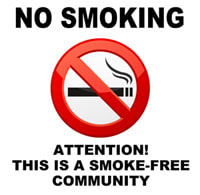By: Kristie Leff

As social acceptance of smoking cigarette smoking changes, smoking in condos is becoming a hot-button issue. Smoking is not a constitutionally protected right, and more people are becoming aware of the health effects of second-hand smoke. As a result, we have seen an increase in complaints from units owners about smoking, and more associations that want to explore smoking bans. That being said, in most cases associations do not have to take any action as this situation can be considered a matter to be addressed between the unit owners themselves: the non-smokers always have a legal right to seek redress against the smoker by bringing a direct action against him in civil court for nuisance. However, if there is a desire among the community to ban smoking in units, or if the smoking complaints may lead to lawsuits being filed, there are measures the association can take address the situation.
For example, most associations have nuisance rules that give the board the authority regulate noxious or offensive activity which may become a nuisance to other unit owners. Such rule provisions can be used to address smoking if it is causing a nuisance for other unit owners. The board can send notice to the smoker that a hearing will be held to address the allegation of nuisance behavior. Based on the evidence presented at the hearing the board can then make a determination as to whether or not the smoking is a nuisance (is there just occasional smoking, or does the smoking happen continually; is the smoke actually emanating into other units; can better ventilation or caulking of cracks remedy the situation; do the complainants have health issues that make them vulnerable to even small amounts of smoke, etc.). If the board determines the smoking is a nuisance and the emanation of the smoke cannot be remedied, the board has the authority to impose fines on the smoker for violation of the nuisance rule.
Another option the board has is to adopt a no-smoking rule pursuant to Connecticut General Statutes Section 47-261b(f)(1). The board always has the power to adopt rules regulating smoking on the common elements. However, this statute allows the board to enact rules to regulate the behavior inside units which adversely affects the use and enjoyment of other units or the common elements by other unit owners. Such a rule can be adopted by the board after notice and comment to unit owners. As with all rules, the unit owners would not get to vote on the rule. Even though an association may already have a rule prohibiting nuisances, a new rule banning smoking in units would directly address the smoking issue and the board would be able to issue fines (after notice and hearing) without having to make a determination as to “nuisance”. Instead, the board need only make a finding that the smoking is adversely affecting others. As this is an emerging area of law, this approach has not been widely utilized, or been challenged in court, so we do not know if this approach will actually stand the test of time.
Instead of adopting a rule, a declaration amendment can be adopted to ban smoking inside units. Regulation of behavior inside of units is considered a “use restriction.” Most declarations allow for implementation of the Connecticut General Statutes Section 47-236(f) procedure to impose a use restriction (such as a smoking ban) upon an affirmative vote of 80% of the unit owner with no objections. The advantage of a declaration amendment as opposed to a rule banning smoking is that a declaration amendment is less susceptible to a legal challenge because it is voted on by the unit owners, not just adopted by the board. The challenging part about a declaration amendment is getting the affirmative 80% of unit owners to vote in favor of it. In order to encourage enough unit owners to vote in favor of a smoking ban, it may be wise to allow a grace period in order to give smokers time to either quit smoking or move out.
Before adopting either a rule or declaration amendment banning smoking, we recommend that the board survey the unit owners to gauge their interest is taking such action. If few unit owners are interested this may not be a worthwhile approach– it may then be best to approach smoking complaints on a case-by-case basis using the existing nuisance provisions of the rules.
Please contact our office should your association want assistance with smoking complaints, or with implementing no-smoking rules or declaration amendments.

